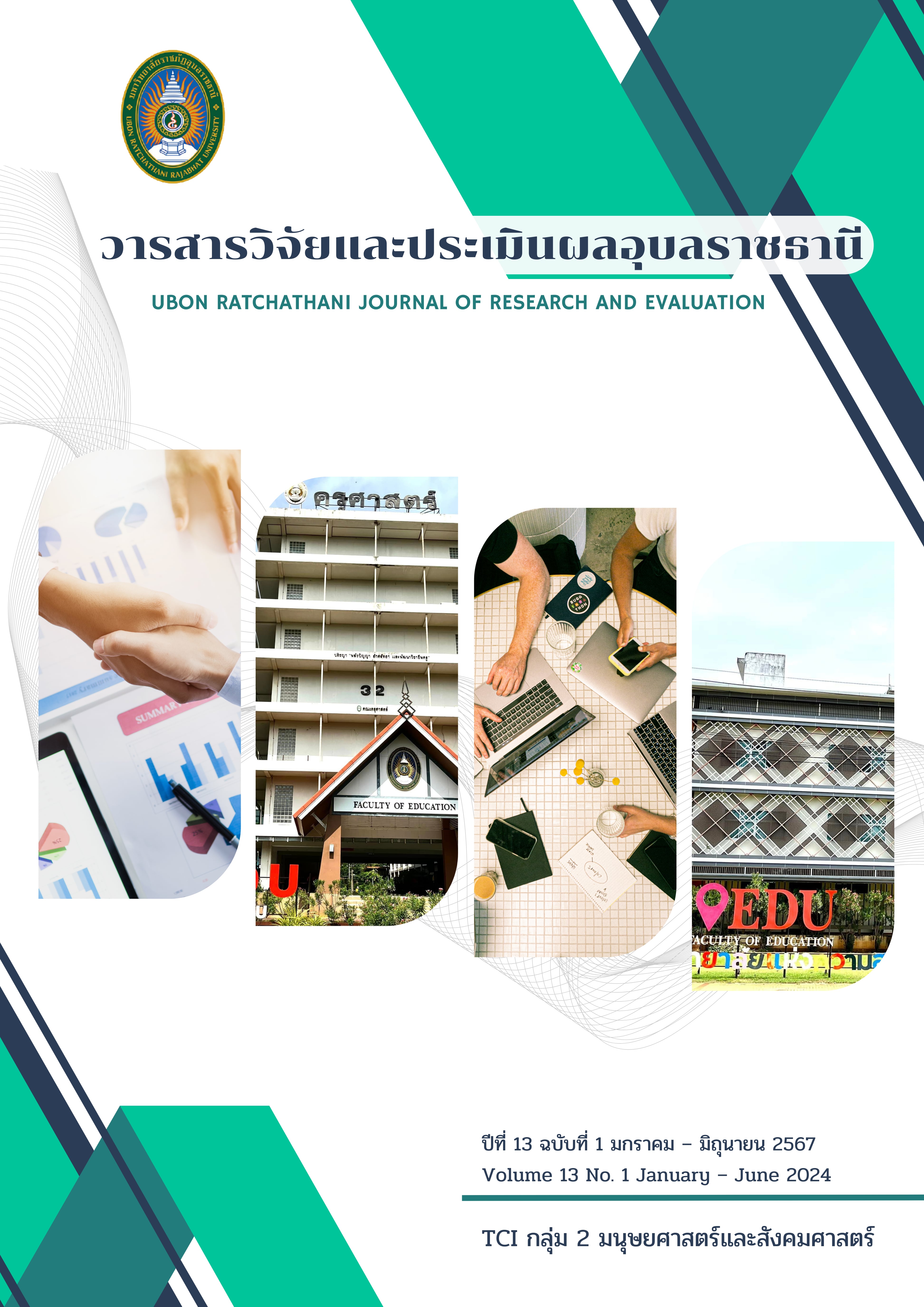The Development of Reading Comprehension Ability of Grade 5 Students by using Scaffolding Learning Management.
Keywords:
reading comprehension, scaffolding learning management modelAbstract
The purpose of this research were 1) to compare the reading comprehension ability of Grade 5 students by using learning management techniques to enhance learning. Before learning and after learning 2) To study the satisfaction of Grade 5 students by organizing learning with techniques to enhance learning. The sample group used in the research was 14 Grade 5 students in the 2nd semester of the 2022 academic year at Ban Na Dun School which were obtained from Cluster Random Sampling using the lottery method. Using network schools is a random unit Research tools include learning management plans. Develop reading comprehension ability with 6 additional techniques for learning. A test to measure reading comprehension ability. It is a multiple-choice test with 4 options, 30 questions, satisfaction questionnaire. Statistics used to analyze the data include mean ( ) standard deviation (S) and t-test (Dependent Samples).
The research findings were as follows:
- Ability to read and understand the main points of Grade 5 students by using learning management techniques to enhance learning. Learning after school is higher than before. Statistically significant at the .05 level, which is in line with the hypothesis set.
- The students who were taught using the scaffolding learning style were satisfied with the learning activities overall at the highest level of satisfaction.
References
กระทรวงศึกษาธิการ. (2551). หลักสูตรแกนกลางการศึกษาขั้นพื้นฐาน พุทธศักราช 2551. กรุงเทพฯ: ชุมนุมสหกรณ์การเกษตรแห่งประเทศไทย.
กมลวรรณ บุตรน้อย. การพัฒนาความสามารถในการอ่านจับใจความและความสามารถในการคิดวิเคราะห์
วิชาภาษาไทยโดยใช้การจัดการเรียนรู้แบบตกผลึกชั้นประถมศึกษาปีที่3. (2563). ปริญญานิพนธ์
การศึกษา มหาบัณฑิต สาขาวิชา วิทยาการทางการศึกษาและการจัดการเรียนรู้
มหาวิทยาลัยศรีนครินทรวิโรฒ.
เกศแก้ว คงคล้าย. (2562). ผลของการเรียนรู้จากตัวแบบร่วมกับกลวิธีการเสริมต่อการเรียนรู้ที่มีต่อความสามารถในการอ่านทำนองเสนาะและเจตคติต่อการอ่าน
ทำนองเสนาะของนักเรียนชั้น มัธยมศึกษาปีที่ 5.
ปริญญานิพนธ์ การศึกษามหาบัณฑิต สาขาวิชาวิทยาการทางการศึกษาและการจัดการเรียนรู้ มหาวิทยาลัยศรีนครินทรวิโรฒ.
บรรพตรี ศรีหะมงคล. (2565). การพัฒนากิจกรรมการเรียนรู้เพื่อเสริมสร้างความสามารถในการอ่านและ
การเขียน คำภาษาไทยที่มีตัวสะกดไม่ตรงตามมาตราโดยใช้การจัดการเรียนรู้ แบบร่วมมือเทคนิค LT ร่วมกับการเสริมต่อการเรียนรู้สำหรับนักเรียนชั้นประถมศึกษาปีที่ 1.
วิทยานิพนธ์ครุศาสตรมหาบัณฑิต สาขาวิชาวิจัยหลักสูตรและการสอน มหาวิทยาลัยราชภัฏสกลนคร.
โรงเรียนบ้านนาดูน. (2565). รายงานการประเมินตนเองของสถานศึกษา ปีการศึกษา 2564 โรงเรียนบ้านนาดูน อุบลราชธานี: โรงเรียนบ้านนาดูน.
ล้วน สายยศ และอังคณา สายยศ. (2538). เทคนิคการวิจัยทางการศึกษา. (พิมพ์ครั้งที่ 4). กรุงเทพฯ: สุวีริยาสาส์น.
วนิดา พรมเขต. (2559). การพัฒนาทักษะการอ่าน. อุดรธานี: คณะมนุษยศาสตร์และสังคมศาสตร์
มหาวิทยาลัยราชภัฏอุดรธานี.
สถาบันทดสอบทางการศึกษาแห่งชาติ. (ม.ป.ป.). รายงานข้อค้นพบตัวชี้วัดที่ควรได้รับการพัฒนาจากการวิเคราะห์ผลการทดสอบทางการศึกษาระดับชาติ
ขั้นพื้นฐาน (O-NET). ชั้น ม.3 (รายงานผลการวิจัย).กรุงเทพฯ: ม.ป.ท.
สิริวรรณ ชัยชนะพีระกุล. (2564). การพัฒนาการอ่านจับใจความสำคัญวิชาภาษาไทยโดยใช้วิธีการสอน
แบบพาโนรามาร่วมกับหนังสือวรรณกรรมเยาวชนสำหรับนักเรียนชั้นประถมศึกษาปีที่ 5.
วิทยานิพนธ์ครุศาสตรมหาบัณฑิต สาขาวิชา หลักสูตรและการสอนคณะครุศาสตร์
มหาวิทยาลัยราชภัฏอุตรดิตถ์.
สุรางค์ โค้วตระกูล. (2556). จิตวิทยาการศึกษา. (พิมพ์ครั้งที่ 8). กรุงเทพฯ: สำนักพิมพ์จุฬาลงกรณ์มหาวิทยาลัย.
Hallenbeck, M., J. (1997). From the Inside Out: Adolescents with Learning Disabilities Think and Talk about Writing.
Retrieved October 30, 2022, from http://thailiscar.chula.ac.th/dua/detail.nsp.
Downloads
Published
How to Cite
Issue
Section
License
Copyright (c) 2024 Ubon Ratchathani Journal of Research and Evaluation

This work is licensed under a Creative Commons Attribution-NonCommercial-NoDerivatives 4.0 International License.
1. บทความที่ตีพิมพ์ในวารสารนี้ได้มีการตรวจสอบการลอกเลียนงานวรรณกรรมแล้ว ไม่เกินร้อยละ 25
2. บทความที่ตีพิมพ์ในวารสารนี้เป็นข้อคิดเห็น ข้อค้นพบของผู้เขียนบทความ โดยผู้เขียนบทความต้องเป็นผู้รับผิดชอบต่อผลทางกฎหมายใด ๆ ที่อาจเกิดขึ้นจากบทความนั้น ๆ
3. บทความ ข้อมูล เนื้อหา รูปภาพ ฯลฯ ที่ได้รับการตีพิมพ์ในวารสารวิจัยและประเมินผลอุบลราชธานี ถือเป็นลิขสิทธิ์ของวารสารวิจัยและประเมินผลอุบลราชธานี หากบุคคลหรือหน่วยงานใดต้องการนำทั้งหมดไปเผยแพร่ต่อหรือเพื่อกระทำการใดๆ จะต้องได้รับอนุญาตเป็นลายลักษณ์อักษรจากวารสารวิจัยและประเมินผลอุบลราชธานีก่อนเท่านั้น และจะต้องมีการอ้างอิงวารสารวิจัยและประเมินผลอุบลราชธานี ฉบับนั้น ๆ ด้วย






